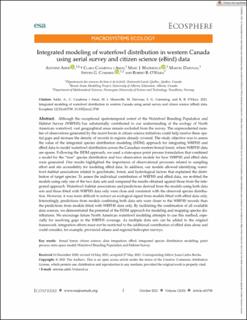| dc.contributor.author | Adde, Antoine | |
| dc.contributor.author | Casabona i Amat, Clara | |
| dc.contributor.author | Mazerolle, Marc J. | |
| dc.contributor.author | Darveau, Marcel | |
| dc.contributor.author | Cumming, Steven G. | |
| dc.contributor.author | OHara, Robert Brian | |
| dc.date.accessioned | 2023-01-11T08:38:07Z | |
| dc.date.available | 2023-01-11T08:38:07Z | |
| dc.date.created | 2021-11-18T15:26:32Z | |
| dc.date.issued | 2021 | |
| dc.identifier.citation | Ecosphere. 2021, 12 (10), 1-20. | en_US |
| dc.identifier.issn | 2150-8925 | |
| dc.identifier.uri | https://hdl.handle.net/11250/3042560 | |
| dc.description.abstract | Although the exceptional spatiotemporal extent of the Waterfowl Breeding Population and Habitat Survey (WBPHS) has substantially contributed to our understanding of the ecology of North American waterfowl, vast geographical areas remain excluded from the survey. The unprecedented number of observations generated by the recent boom in citizen science initiatives could help resolve these spatial gaps and increase the density of records in regions already covered. The study objective was to assess the value of the integrated species distribution modeling (ISDM) approach for integrating WBPHS and eBird data to model waterfowl distribution across the Canadian western boreal forest, where WBPHS data are sparse. Following the ISDM approach, we used a state-space point process formulation that combined a model for the “true” species distribution and two observation models for how WBPHS and eBird data were generated. Our results highlighted the importance of observational processes related to sampling effort and site accessibility for modeling eBird data. In addition, our models allowed identifying waterfowl–habitat associations related to geoclimatic, forest, and hydrological factors that explained the distribution of target species. To assess the individual contribution of WBPHS and eBird data, we re-fitted the models using only one of the two data sets and compared the results obtained against those from the integrated approach. Waterfowl–habitat associations and predictions derived from the models using both data sets and those fitted with WBPHS data only were close and consistent with the observed species distribution. However, it was more difficult to extract an ecological signal from models fitted with eBird data only. Interestingly, predictions from models combining both data sets were closer to the WBPHS records than the predictions from models fitted with WBPHS data only. By facilitating the combination of all available data sources, we demonstrated the potential of the ISDM approach for modeling and mapping species distributions. We encourage future North American waterfowl modeling attempts to use this method, especially for resolving gaps in the WBPHS coverage. As multiple data sets can be added to the original framework, integration efforts must not be restricted to the additional contribution of eBird data alone and could consider, for example, provincial atlases and regional helicopter surveys. | en_US |
| dc.language.iso | eng | en_US |
| dc.publisher | Ecological Society of America | en_US |
| dc.rights | Navngivelse 4.0 Internasjonal | * |
| dc.rights.uri | http://creativecommons.org/licenses/by/4.0/deed.no | * |
| dc.title | Integrated modeling of waterfowl distribution in western Canada using aerial survey and citizen science (eBird) data | en_US |
| dc.title.alternative | Integrated modeling of waterfowl distribution in western Canada using aerial survey and citizen science (eBird) data | en_US |
| dc.type | Peer reviewed | en_US |
| dc.type | Journal article | en_US |
| dc.description.version | publishedVersion | en_US |
| dc.source.pagenumber | 1-20 | en_US |
| dc.source.volume | 12 | en_US |
| dc.source.journal | Ecosphere | en_US |
| dc.source.issue | 10 | en_US |
| dc.identifier.doi | 10.1002/ecs2.3790 | |
| dc.identifier.cristin | 1956082 | |
| cristin.ispublished | true | |
| cristin.fulltext | original | |
| cristin.qualitycode | 1 | |

